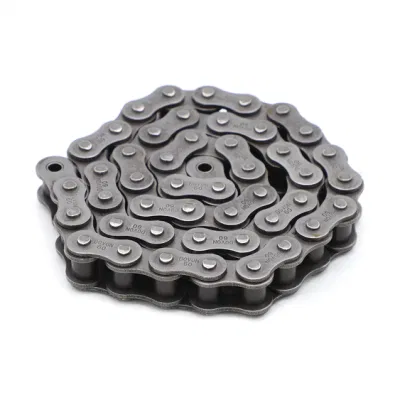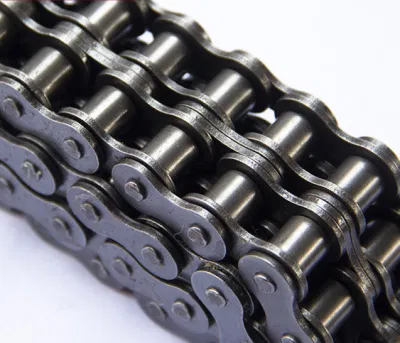Product Description
Precision Standard Timing Chains (Bush Chains)
Products are made of high quality alloy steel production. The plates are punched and squeezed bores by precision technology. The pin, bush, roller are machined by high-efficiency automatic equipment and automatic grinding equipment, then through heat treatment of carburization, carbon and nitrogen protection mesh belt furnace, surface blasting process etc. Assembled precision by Internal hole position, spin riveted by pressure to ensure the performance of the entire chain.
Specifications
| Technique Treatment | |||
| 1 | Shot Peening | 8 | Tempering |
| 2 | Bluing | 9 | Oiling |
| 3 | Nickel-plated | 10 | Greasing |
| 4 | Zincing | 11 | Special color |
| 5 | Heat Treatment | 12 | Stain proofing |
| 6 | Carburizing | 13 | Pre-stretched and anti-fatigue |
| 7 | Quenching | ||
Our Service
1. Any of your kind inquiry conveyor chain would be replied within 24 hours.
2. Well-trained and experienced sales staffs will reply all your concerns in fluent English.
3. OEM services are available with us, our professional designer would make your private idea into being.
4. Protection of your sales area, ideas of design and all your private information.
5. Delivery by air mail or ship for your orders.
Why choose us
1. We are the manufacture.
2. We have near 30 years experience of making chains and chain links.
3. Our design team has extensive experience in the chain design.
4. Best service and prompt delivery.
5. We offer various styles, size and colors to meet your requirement.
6. We covering a production area of 18750 square CHINAMFG have more than 100 employees and we have a complete set of testing equipment to ensure our quality.
| Surface Treatment: | Oxygenation |
|---|---|
| Structure: | Roller Chain |
| Material: | Alloy/Carbon Steel |
| Sample: | Available |
| Packages: | Can Be Customized |
| OEM: | Available |
| Samples: |
US$ 0/Piece
1 Piece(Min.Order) | |
|---|
| Customization: |
Available
| Customized Request |
|---|

How does a bush chain compare to other types of power transmission systems?
Bush chains offer several advantages and differences compared to other types of power transmission systems. Here are some key points of comparison:
1. Simple design and construction: Bush chains have a relatively simple design, consisting of inner and outer plates connected by bushings and pins. This simplicity makes them easy to manufacture, assemble, and maintain compared to more complex power transmission systems.
2. High strength and durability: Bush chains are known for their high strength and durability. They are designed to withstand heavy loads and resist wear, making them suitable for demanding industrial applications.
3. Wide range of speed and load capacities: Bush chains are capable of handling a wide range of speeds and loads. They can effectively transmit power in both high-speed and high-torque applications, providing versatility in various industrial settings.
4. Compact size and space-saving: Bush chains have a compact design, allowing them to be used in tight spaces and constrained environments. They offer efficient power transmission without requiring excessive space or complicated installations.
5. Cost-effective solution: Bush chains are often a cost-effective option for power transmission systems. Their simple design and availability of standardized components make them affordable compared to more specialized systems.
6. Reliable and low-maintenance: Bush chains are known for their reliability and require minimal maintenance. Proper lubrication and periodic inspections are typically sufficient to keep them operating smoothly and extend their service life.
7. Limited shock absorption: While bush chains provide excellent power transmission capabilities, they have limited shock absorption compared to systems like belts or elastomeric couplings. This makes them more suitable for applications where consistent power transmission is required rather than situations with significant shock loads.
Overall, bush chains offer a balance of strength, reliability, and cost-effectiveness, making them a popular choice for power transmission in various industrial settings.

How do you ensure proper tensioning and alignment of a bush chain?
Proper tensioning and alignment of a bush chain are crucial for its optimal performance and longevity. Here are the steps to ensure proper tensioning and alignment:
1. Tensioning:
– Consult the manufacturer’s guidelines: Refer to the manufacturer’s specifications or guidelines for the recommended tensioning method and tension values specific to the bush chain you are using.
– Check the sag: Measure the sag of the chain between two sprockets. The sag should be within the recommended range provided by the manufacturer. Adjust the tension as necessary to achieve the proper sag.
– Use a tensioning device: Depending on the application, you may use a tensioning device such as a tensioner or an idler sprocket to achieve the desired tension. These devices help maintain the tension over time as the chain wears.
2. Alignment:
– Visual inspection: Visually inspect the alignment of the chain with the sprockets. Ensure that the chain is properly seated on the sprocket teeth and running parallel to the sprocket shaft.
– Sprocket alignment: Check the alignment of the sprockets themselves. They should be aligned with each other and positioned correctly on their respective shafts.
– Adjustment: If misalignment is detected, make the necessary adjustments to align the chain and sprockets. This may involve repositioning the sprockets or adjusting the tensioning devices.
3. Regular inspection and maintenance:
– Periodically check the tension and alignment of the bush chain during routine maintenance. This ensures that any changes or deviations can be detected and corrected promptly.
– Monitor wear and elongation: Over time, bush chains may experience wear and elongation. Regularly measure the chain length or inspect for signs of elongation to determine if chain replacement or adjustment is necessary.
Proper tensioning and alignment of a bush chain optimize its performance, minimize wear, and reduce the risk of premature failure. Following the manufacturer’s guidelines and performing regular inspections and maintenance will help ensure the proper tensioning and alignment of the bush chain in your application.

How do you select the right bush chain for your application?
Choosing the right bush chain for your application is essential to ensure optimal performance and longevity. Here are some factors to consider when selecting a bush chain:
1. Load Capacity: Evaluate the maximum load that the chain will need to transmit. Consider factors such as weight, acceleration, and shock loads. Choose a bush chain with a load capacity that exceeds the anticipated load to ensure reliable operation.
2. Speed: Determine the operating speed of the chain. Higher speeds may require chains with specialized designs to minimize wear, reduce friction, and maintain accurate timing.
3. Environmental Conditions: Assess the environmental conditions in which the chain will operate. Consider factors such as temperature, humidity, dust, chemicals, and exposure to corrosive substances. Select a bush chain that is designed to withstand the specific conditions of your application.
4. Size and Configuration: Determine the required chain size based on the available space and the dimensions of the sprockets or pulleys. Consider the pitch, width, and overall dimensions of the chain. Additionally, assess whether a standard or custom configuration is needed to meet the application requirements.
5. Lubrication Requirements: Determine the lubrication method and frequency required for the chain. Some bush chains are self-lubricating, while others may require regular lubrication. Consider the availability of lubrication systems and the maintenance requirements of the chain.
6. Reliability and Durability: Assess the expected operational lifespan and the reliability requirements of your application. Look for bush chains from reputable manufacturers known for producing high-quality, durable products. Consider factors such as wear resistance, fatigue strength, and overall reliability.
7. Cost: Evaluate the cost-effectiveness of the bush chain, considering both the initial investment and long-term maintenance costs. Balance the performance requirements with the available budget.
Consult with a knowledgeable supplier or engineer to ensure you select the right bush chain that meets your specific application requirements. They can provide guidance based on their expertise and help you choose a chain that offers optimal performance and durability.


editor by CX 2023-10-17
